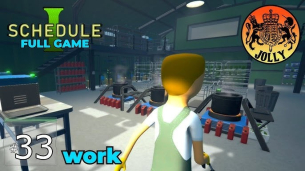Inside the Mind: My Descent into the Strange World of Schedule I
Every once in a while, a game comes along that doesn't just ask for your attention—it demands your surrender. Schedule I, an experimental indie horror experience from Redact Games, isn’t about simple mechanics or casual play. It’s a dive into the subconscious, a psychological puzzle wrapped in a minimalist aesthetic that hides more than it reveals.
I went into Schedule I blind, not knowing what to expect beyond the vague description of "a walk through the mind." What I got was an unforgettable spiral into atmospheric unease, with narrative ambiguity that lingered long after I shut it down.
Atmosphere: Silent Screams in Empty Hallways
The first thing that hits you is the silence. Not the peaceful kind, but the tense, pressing quiet that feels like it’s watching you. The game uses audio sparingly but intentionally—small creaks, occasional echoes, and ambient distortions feed the dread better than any jump scare. In fact, Schedule I rarely relies on traditional horror elements. It’s not about what you see—it’s about what you feel when you see nothing.
Visually, it's stark and raw. There’s a retro low-poly charm reminiscent of early 3D games, which enhances the discomfort rather than detracts from it. The simple graphics leave room for your imagination to fill in the horror, and believe me, it does.
Storytelling: Fragmented, But Purposeful
Don’t expect a straightforward narrative. Instead, Schedule I presents a scattered tale told through environmental hints, cryptic messages, and momentary flashes of clarity. It never spells things out for you, which can be both frustrating and exhilarating. You’re piecing together someone’s unraveling psyche, and like any real memory, it’s unreliable and inconsistent.
I spent nearly an hour just re-walking sections, trying to decipher what meant what. One room had scribbled text that changed each time I returned. Another seemed empty until a second pass revealed a faint audio recording. These aren’t bugs—they’re features. The game bends time and space in a way that makes you question not just the environment, but your own perception.
Gameplay: Minimalist Mechanics, Maximum Impact
Mechanically, there’s not much to it. You walk, you observe, you interact sparingly. No combat, no inventory management. It’s more of a narrative exploration game, or “walking simulator” as some might call it. But dismissing it as such would miss the point. The lack of mechanics allows your focus to remain on the atmosphere and the internal monologue the game plants in your mind.
Still, some players might be turned off by this design. If you're looking for action or skill-based challenges, this isn’t your game. Schedule I is more psychological examination than digital playground.
Emotional Response: A Game That Gets Under Your Skin
I play a lot of horror titles. Many try to unsettle you with grotesque imagery or overused tropes. Schedule I took a different route. It made me feel isolated. Disoriented. Vulnerable. The slow pacing and quiet spaces gave my mind room to wander—and when it did, the game was right there waiting to shape that wandering into anxiety.
It reminded me of the first time I played Yume Nikki or Anatomy. There’s a special kind of fear that comes from being alone in a space you don’t understand. And Schedule I captures that feeling with disturbing accuracy.
Replayability: A Second Run Feels Like a New Game
Because the story is so cryptic and the environment subtly shifts, each playthrough can reveal something new. On my second run, I took different paths and triggered events I never saw the first time. There’s no hand-holding, so experimentation is rewarded. And for players who enjoy speculation and theorycrafting, this game is a goldmine.
I even joined a small community forum after playing, just to compare notes with others. No two players seemed to interpret the story the same way, and that’s a rare thing in modern gaming.
Final Thoughts: Not for Everyone, But Unforgettable for Some
Schedule I isn’t a game that wants to be loved by the masses. It’s a quiet, eerie, deeply personal experience. If you're a fan of psychological horror, narrative exploration, and games that leave interpretation up to you, this one deserves a place in your library.
It’s short, strange, and unsettling in all the right ways.
Verdict
If you’ve ever wanted to explore the abstract corridors of a fractured mind—and are willing to do so without weapons, maps, or obvious objectives—then Schedule I is waiting. It doesn’t explain itself, and it doesn’t care if you’re comfortable. And maybe that’s exactly why it’s so memorable.









